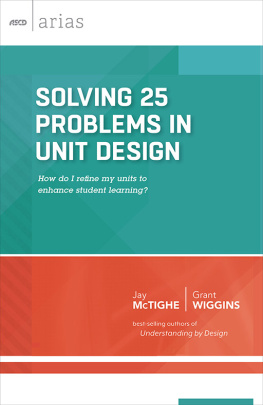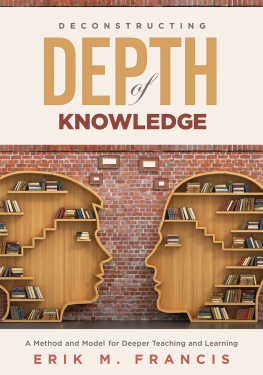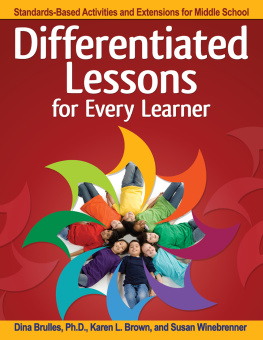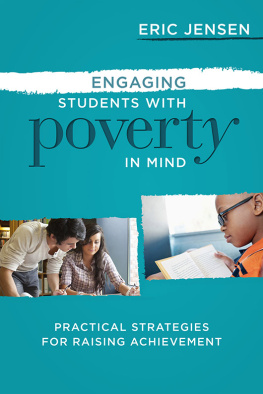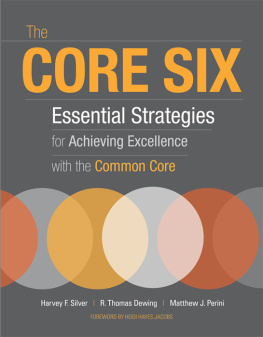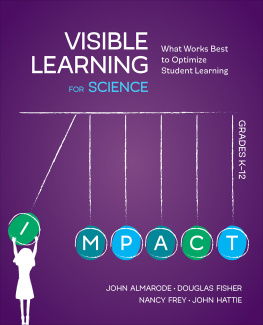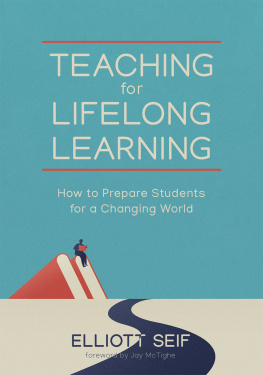Contents
Guide
Pages
Praise for Teaching for Deeper Learning
....................
Jay McTighe and Harvey Silver bring together their wealth of knowledge and ideas around powerful thinking skills, essential questions, and concept-based curriculum to help teachers effect deep learning and transfer. They had the insight to see how using seven major thinking skills to facilitate greater knowledge acquisition could become the springboard to the crafting of "big ideas"the transferable, conceptual understandings that reflect deep learning. This easy-to-read book flows from chapter to chapter with practical tools, ideas, and examples to guide the teacher in facilitating meaning making.
Education offers a plethora of individual innovations, but when curriculum and instruction leaders can combine the power of the best ideas to create not only a higher-order end but also a clear means to that end, then they have truly made a significant contribution to the field. This book is one of those contributions.
Dr. H. Lynn Erickson, author and presenter
This is the book you'll want to extend your instructional skills and expand your backpack of strategies to support how the brain learns best. By engaging thinking skills to help students actively process information, teachers leverage the brain's executive functions to deepen student understanding and achieve learning that lasts.
I have room for only five reference books on my desk, and Teaching for Deeper Learning just took over the top spot.
Judy Willis, MD, MEd, Board-certified neurologist, teacher, author, and consultant
Because all the knowledge in the world is on the phone in nearly every student's pocket, a person's ability to thrive in the modern world is based on their ability to analyze the veracity of information, make sense of its context and perspective, draw conclusions, take responsible action (often in concert with others), assess the impact of that action, and reassess based on new information. Teaching for Deeper Learning gives teachers the tools to equip students with these critical capacities.
Michael R. Cornell, Superintendent, Hamburg Central School District (New York)
Dedication
....................
Sir Isaac Newton said the reason he saw so far is that he stood on the shoulders of giants. We have also worked with two giants: Richard Strong and Grant Wiggins. They were wonderful friends, colleagues, and education thought leaders. Although they are no longer with us, their ideas are alive within this book, which we humbly dedicate to them.
Acknowledgments
....................
Writing this book was a labor of love for both of us. It's not a simple task to synthesize ideas from nearly 100 years of collective work developed over two parallel careers. Throughout the process, we have had rich conversations, raised questions, and even debated several points, but in the end, we think this text represents a truly collaborative integration of the ideas of Understanding by Design and The Thoughtful Classroom.
The publication of our book would not have been possible without the help of a marvelous writing team. We would like to thank Matthew Perini, a master craftsman and wordsmith whose guidance and direction were essential in helping us achieve a synthesis of our ideas; Abigail Boutz, a critical friend who helped ensure that our writing was clear and our tools and strategies were practical and user-friendly; Justin Gilbert, our internal editor who made sure that all the details were correct and that the manuscript was delivered on time; and Kimberly Nunez, whose willingness to jump in and help throughout the process saved us more than once.
We would also like to acknowledge ASCD for its support throughout the years and for giving us the opportunity to share our ideas with the field. In particular, we thank the ASCD publishing team, notably Stefani Roth, Genny Ostertag, and our capable editor, Miriam Calderone, for their support from the book's inception to its publication.
Finally, we give thanks to the thousands of teachers and administrators with whom we have worked during our long careers. We have learned so much from you, and we hope that our book will give something back to the profession.
Jay and Harvey
Preface
....................
Legend has it that the world-renowned architect and thinker Buckminster Fuller once told an aspiring young architect that a great design must achieve four goals. Fuller framed these goals as the following four simple questions:
- Does the design meet its intended purpose?
- Is it functional?
- Will people like it?
- Is it beautiful?
These four questions have guided the design of this book. First, we set out with a clear purpose: to help educators make the critical shift from providing information to students (a knowledge consumption model) to empowering students to become active meaning makers who seek deep understanding and are able to transfer their learning.
Second, because it has been our experience that educators are looking for resources that are practical and easy to implement in their classrooms, we strove to make our book highly functional, providing a wealth of ready-to-use tools and strategies to help you put its ideas into practice immediately.
To help us address the question Will people like it?, we have tested and refined the book's ideas and tools in our workshops, coaching partnerships, and professional development work in schools. We are proud to say that the feedback from educators has been extremely positive and enthusiastic.
Then there's that last question, the most subjective one of all: Is it beautiful? One way to think of beauty is as something that is both simple and deep, like a haikueasy to comprehend but profound in its effect. In writing a book full of simple tools designed to create deep change in classrooms and schools, we sincerely hope that we have met this beautiful standard of simplicity and depth. Most important, we hope that we inspire youa designer of instructionto see the beauty in what you teach, in how you teach it, and in the impact your work has on students' futures.
Introduction
....................
Mitosis versus meiosis, logarithms, the Battle of Hastings: can you recall a time in high school or college when you "learned" something and were able to pass a test on it, only to quickly forget it? Perhaps the information was not important to you, or maybe you only learned it by rote. Cognitive psychologists have characterized such learning as inert knowledgelearning that was superficially acquired, never really understood, and promptly forgotten (National Research Council, 2000). Now contrast those examples with something that you really understandlearning that has endured. What is the difference in how you came to learn and understand it? What can you now do because of that understanding?
These differences are familiar to us, and they underscore one of the chief goals of this book: to promote deep and lasting learning that enhances the retention of information, leads to conceptual understanding, and equips students to be able to transfer their learning to new situations.
But what does it mean to learn something deeply? We propose that deep learning results in enduring understanding of important ideas and processes. However, we also contend that understanding must be "earned" by the learner. In other words, understanding is not something that teachers can transmit simply by telling. Although we can directly teach facts and procedures, understanding of conceptually larger ideas and abstract processes must be constructed in the mind of the learner. Students earn understanding through the active mental manipulation of content via higher-order thinking skills. We refer to this active construction of meaning by students as


